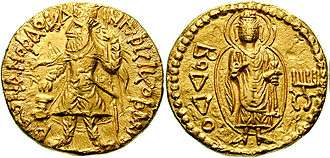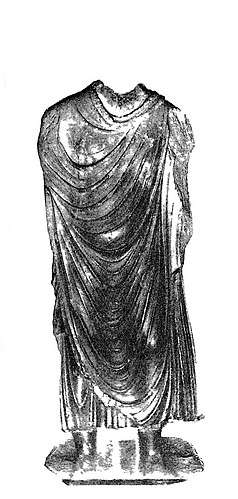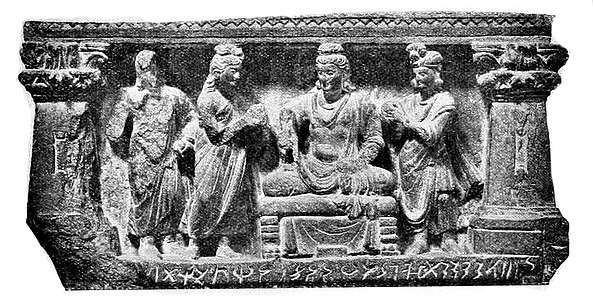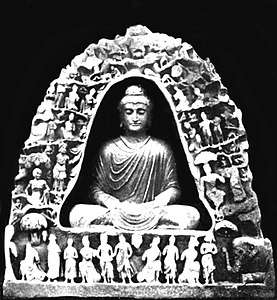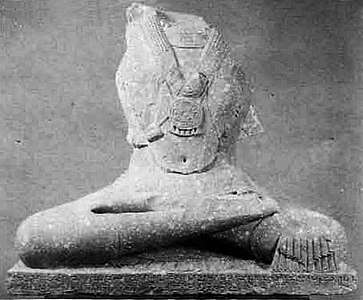Vasudeva I
Vasudeva I (Kushano Bactrian: ΒΑΖΟΔΗΟ "Bazodeo"; Middle Brahmi script: ![]()
![]()
![]()
![]()
| Vasudeva I | |
|---|---|
| Kushan emperor | |
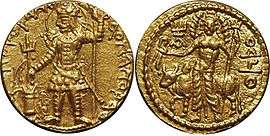 Gold coin of Vasudeva I or II. Obv: Vasudeva in tall helmet, holding a scepter, and making an offering over an altar. Legend in Kushan language and Greek script (with the Kushan letter Ϸ "sh"): ϷΑΟΝΑΝΟϷΑΟ ΒΑΖΟΔΗΟ ΚΟϷΑΝΟ ("Shaonanoshao Bazodeo Koshano"): "King of kings, Vasudeva the Kushan". | |
| Reign | 191–232 CE |
| Predecessor | Huvishka |
| Successor | Kanishka II |
| Dynasty | Kushan |
| Kushan Empire 30 CE–350 CE | ||||||||||||||||||||||||||||||
|---|---|---|---|---|---|---|---|---|---|---|---|---|---|---|---|---|---|---|---|---|---|---|---|---|---|---|---|---|---|---|
|
||||||||||||||||||||||||||||||
The last named inscription of his predecessor, Huvishka, was in the year 60 = 187 CE, and the Chinese evidence suggests he was still ruling as late as 229 CE.
His name, Vasudeva, is that of the father of Krishna, the popular Hindu God, and he was the first Kushan king to be named after the Indian God. He converted to Hinduism during his reign.[2][3] His name reinforces the notion that his center of power was in Mathura.[1]
Contacts with China
In the Chinese historical chronicle Sanguozhi (三國志), he is recorded to have sent tribute to the Chinese emperor Cao Rui of the Wei in 229 CE (3rd year of Taihe 太和), :
- "The king of the Da Yuezhi, Bodiao (波調) (Vāsudeva), sent his envoy to present tribute and His Majesty granted him a title of "King of the Da Yuezhi Intimate with Wei (魏)"." (Sanguozhi)
He is the last Kushan ruler to be mentioned in Chinese sources.[1] His rule corresponds to the retreat of Chinese power from Central Asia, and it is thought that Vasudeva may have filled the power vacuum in that area.[1] The great expansion of the Dharmaguptaka Buddhist group in Central Asia during this period has also been related to this event.
Coinage
The coinage of Vasudeva consisted in gold dinars and quarter dinars, as well as copper coins. Vasudeva almost entirely removed the pantheon of deities displayed in the coinage of Kanishka and Huvishka. Apart from a few coins with the effigies of Mao and Nana, all of Vasudeva's coins feature Oesho on the reverse, who is generally identified as Shiva. On the obverse, Vasudeva restored the royal imagery of Kanishka, with the standing, making a sacrifice over an altar, although he holds a trident rather than Kanishka's spear and he appears nimbate. Another trident is sometimes also added over the small sacrificial altar. At the end of his rule, Vasudeva introduced the nandipada symbol (![]()
Sassanid invasion in the northwest
Vusadeva I was the last great Kushan emperor, and the end of his rule coincides with the invasion of the Sassanians as far as northwestern India, and the establishment of the Indo-Sassanians or Kushanshahs from around 240 CE.[1] Vasudeva I may have lost the territory of Bactria with its capital in Balkh to Ardashir I Kushanshah. Thereafter, Kushan rule would be restricted to their eastern territories, in western and central Punjab.
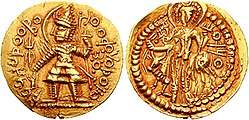 An imitation of a coin of Vasudeva I, by the Kushano-Sasanian ruler Ardashir I Kushanshah, circa 230-245 CE.[6]
An imitation of a coin of Vasudeva I, by the Kushano-Sasanian ruler Ardashir I Kushanshah, circa 230-245 CE.[6] Gold coin of Peroz I Kushanshah (246-275 CE), imitating the design of Vasudeva I, minted at Balkh.[7]
Gold coin of Peroz I Kushanshah (246-275 CE), imitating the design of Vasudeva I, minted at Balkh.[7]
Statuary

The relatively peaceful reign of Vasudeva is marked by an important artistic production, in particular in the area of statuary.[1] Several Buddhist statues are dated to the reign of Vasudeva, and are important markers for the chronology of Buddhist art.[8]
An inscription with the base of a Buddha statue is also known from the Mathura Museum: "In the 93rd year of Maharaja Devaputra Vasudeva...", probably corresponding to circa 171 CE, or 220 CE with the more recent definition of the Kanishka era as starting in 127 CE.[9] A partially preserved Sakyamuni statue, also from Mathura, has the date "Year 94", although without mentioning Vasudeva specifically.[10]
| Statuary dated to the reign of Vasudeva I | |
| |
References
- Rezakhani, Khodadad (2017). From the Kushans to the Western Turks. p. 202.
- Coins of India Calcutta : Association Press ; New York : Oxford University Press, 1922
- Kumar, Raj (1900). Early history of Jammu region. Gyan Publishing House. p. 477. ISBN 9788178357706.
- Rosenfield, John M. (1967). The Dynastic Arts of the Kushans. University of California Press. p. 111.
- Shrava, Satya (1985). The Kushāṇa Numismatics. Praṇava Prakāshan. p. 11.
- CNG Coins
- Cribb, Joe (2010). "The Kidarites, the numismatic evidence". Coins, Art and Chronology II: The First Millennium C.E. In the Indo-Iranian Borderlands, Edited by M. Alram et Al.: 98.
- Rhi, Juhyung (2017). Problems of Chronology in Gandharan. Positionning Gandharan Buddhas in Chronology (PDF). Oxford: Archaeopress Archaeology. pp. 35–51.

- Sharma, R.C. (1994). The Splendour of Mathura Art and Museum. D. K. Printworld Pvt. Ltd. p. 140.
- Indian Archaeology, 1994-1995 (PDF). p. 100, Plate XLVI.
- Problems of Chronology in Gandharan Art p.37
- Errington, Elizabeth. Numismatic evidence for dating the Buddhist remains of Gandhara. p. 204.
- Indian Archaeology, 1994-1995 (PDF). p. 100, Plate XLVI.
Bibliography
- Falk, Harry (2001). "The yuga of Sphujiddhvaja and the era of the Kuṣâṇas." Silk Road Art and Archaeology VII, pp. 121–136.
- Falk, Harry (2004). "The Kaniṣka era in Gupta records." Harry Falk. Silk Road Art and Archaeology X, pp. 167–176.
- Sims-Williams, Nicholas (1998). "Further notes on the Bactrian inscription of Rabatak, with an Appendix on the names of Kujula Kadphises and Vima Taktu in Chinese." Proceedings of the Third European Conference of Iranian Studies Part 1: Old and Middle Iranian Studies. Edited by Nicholas Sims-Williams. Wiesbaden. Pp, 79-93.
External links
| Preceded by Huvishka |
Kushan Ruler | Succeeded by Kanishka II |
- From the dated inscription on the Rukhana reliquary
- An Inscribed Silver Buddhist Reliquary of the Time of King Kharaosta and Prince Indravarman, Richard Salomon, Journal of the American Oriental Society, Vol. 116, No. 3 (Jul. - Sep., 1996), pp. 442
- A Kharosthī Reliquary Inscription of the Time of the Apraca Prince Visnuvarma, by Richard Salomon, South Asian Studies 11 1995, Pages 27-32, Published online: 09 Aug 2010
- Cribb, Joe; Donovan, Peter (2014). Kushan, Kushano-Sasanian, and Kidarite Coins A Catalogue of Coins From the American Numismatic Society by David Jongeward and Joe Cribb with Peter Donovan. p. 4.

